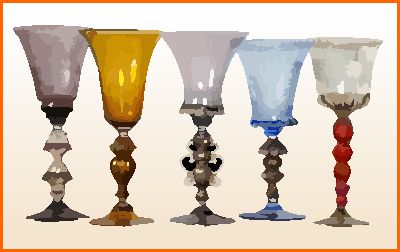Crystal wine glasses from companies like Waterford and Baccarat retail for up to $100 per stem and their delicate rims often get chipped by careless handling. Considering the price and sentimental attachment – is it worthwhile to fix a chip in a wine glass?
Expensive crystal brands like Waterford are worth repairing. A small chip in a wine glass can be fixed at home but complete repair needs professional equipment.
Types of damage suffered by crystal and glassware
Glass is brittle and fragile and so it is very easily chipped, cracked, and broken. The main categories of damage to wine glasses are chips, cracks, and broken stems.
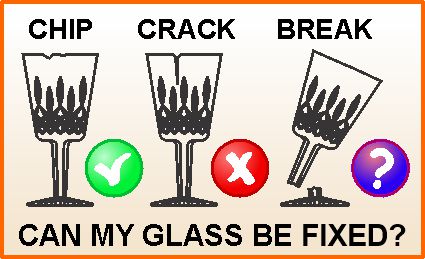
Chipped glasses can be successfully repaired – read below
Cracked glasses cannot be fixed – follow this link to find out more
Broken stems can sometimes be fixed – follow this link to find out more
How do glasses get chipped?
Chips form when a sharp or thin glass edge suffers stress by being hit by a hard object. Chips can happen on the rims or bases of glasses, vases, or bowls. The thinner and sharper the edge – the more easily it is chipped.
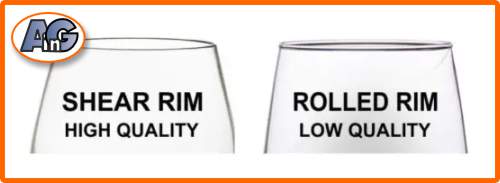
Jump to this section to learn more about chips – how they are caused and how to avoid them.
As an Amazon Associate, I earn from qualifying purchases
How do I repair chipped rims?
Two ways that do not work are:
1) Filling the chip with resin or other material
Optically clear resins are effective in filling cracks and dings in windshields but do not work on wine glass rims because they cannot be made to stick to the glass through cycles of use and cleaning. Also, the refractive index (RI) of available resins is lower than the RI of lead crystal so the filled chip is unsightly.
Using resin can sometimes work to fill large chips in glass tabletops;
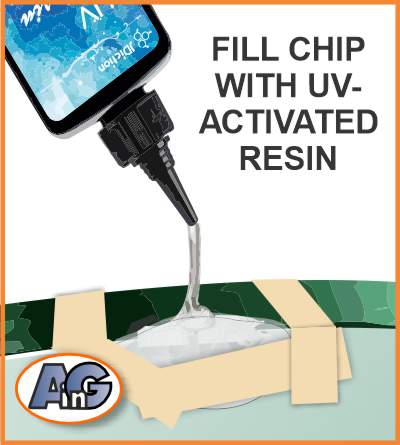
See this 2023 post for how to repair chipped glass tabletops.
2) Melting or fusing the glass
Chips cannot be smoothed by magically melting or fusing the glass. It is extremely difficult to selectively heat parts of a crystal glass without cracking it (unlike borosilicate or pyrex).
Two ways that do work are:
3) Smoothing down the chip
Smoothing a jagged chip to make it safe to use can be done by any handy homeowner using the methods explained below. It is the recommended approach for inexpensive but favorite drinking glasses that do not justify the expense of professional repair.
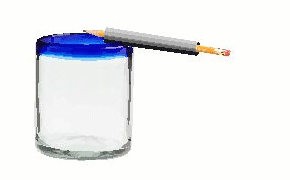
Do-it-yourself chip smoothing
Recommended for the thrifty homeowner who does not want to pay a professional – or cannot find a professional glass polisher
Jump to this link to learn all about smoothing your own glasses.
4) Grinding away the chip – the professional method
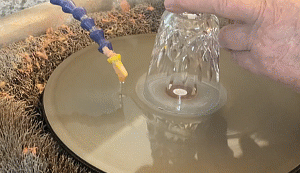
Professional polishing using a rotating lap with diamond abrasives. The most satisfactory repair grinds and polishes the entire rim down until the chip disappears.
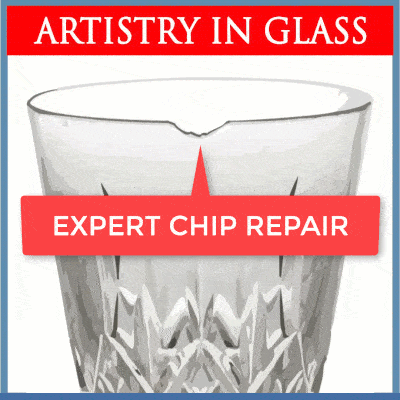
Waterford Lismore Pattern Glass
This classic Waterford crystal pattern turns out as good as new after careful polishing by the experts at Artistry in Glass. The only difference is that the glass is just a little shorter than the original.
The cost of repair depends on the size of the chip – a bigger chip will need more grinding and therefore take longer and cost more. The process is not recommended if the chip is a large chunk of missing glass.
Do-it-yourself chip smoothing – all you need to know
The cost of industrial diamonds has plummeted over the last 10 years and diamond files are a very affordable way to grind and smooth glass. This is because diamond, with a hardness of 10, is much much harder than glass (hardness 6 for glass and 5 for lead crystal).
Diamond file for smoothing chips
File (available on Amazon) advertised specifically for glass has 200 grit diamonds embedded in a carbide steel rod that has a rounded and a flat side for versatile smoothing.
We feel that if you are going to the trouble of buying diamond files you will be better off purchasing the selection below because it comes in three grit sizes – 140#, 200#, and 400#. Learn about grit sizes here:
7 Inch long diamond-coated file set features three grit sizes (140/200/400) for rough, medium, and smooth grinding. This set of files allows you to remove sharp edges with a coarse file and then finish with a finer (400 grit) file.
Here is another good set of files with varying grit sizes: Files are 7″ / 180mm long in 40, 80, 150, 240, 400, & 600 grits
Using sandpaper instead of diamond files
If you would rather not bother to order diamond files from Amazon, wet and dry sandpaper from your local hardware store will do the job just as well.
Wrapping the sandpaper around a pencil provides an easy way to smooth chips. Depending on the size of the chip, start with a coarse (#100) grit and work down through the grits to fine (#400) or even superfine (#1200).
The benefit of sandpaper is that, by using a fine grit, you can achieve a finer polish than with a diamond file. The disadvantage is that silicon carbide is not as abrasive as diamond (Moh’s hardness =9 compared to 10 for diamond). So for big chips in hard glass, a diamond file will be faster.
Wet Dry sandpaper is made of silicon carbide grit embedded in a durable substrate. Choose this selection of 320 thru 10,000 grits to permit smoothing and fine polishing of the chip
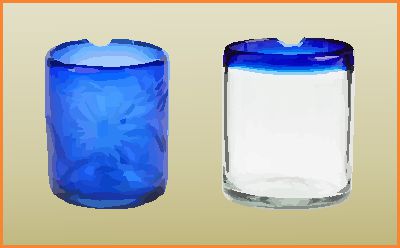
The irony of chipped crystal and glassware is that expensive lead crystal is cheaper to repair than inexpensive glass. This is because cheap, soda-lime glass is much harder than lead crystal and therefore takes longer to grind and polish. The cost of repair will probably be more than the cost of a replacement glass!
Chips in the foot of a wine glass
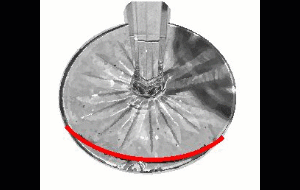
A chip in the foot of a Lismore wine glass
There is no perfect way to fix a cracked foot but the out-of-round base is acceptable to many customers as a way of salvaging a valuable crystal wine glass.
Chips in American Cut Crystal
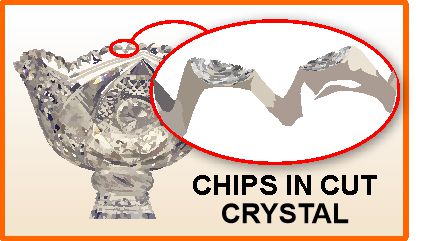
Chips in the crenulated rims of American Cut Crystal are a very common type of damage The best solution is to smooth off the sharp edges by hand using diamond files recommend in this article.
As an Amazon Associate, I earn from qualifying purchases
Cracks in crystal and glassware
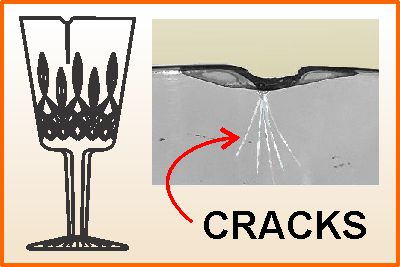
Cracks in crystal rims are hard or impossible to repair:
Sometimes a chip in the rim is associated with a crack. Normal polishing methods, on a mechanical lap, create vibrations that make the crack “run” (extend downwards).
Heroic methods to fix cracks
Cracks are very seldom possible to fix but two extreme and unsatisfactory options are available:
- Plan A: carefully drill a small hole (with a diamond drill bit in a Dremel) just beyond the start of the crack, This hole will stop the crack from running
- Plan B: mask off the glass below the crack and sandblast the top of the bowl away. Then polish the remaining glass (results in a much smaller bowl).
If your Lismore pattern Waterford glasses
are cracked and beyond repair – why not treat yourself to a replacement?
Broken stems – hard and expensive to fix
Broken stems are the most serious damage to befall wine glasses. The problem is that, even if the break is clean, the surface area of the broken stem parts is too small to provide a secure gluing joint.
Artistry in Glass has a cunning method to overcome this problem which involves using a new stem, cut from a sacrificial glass and glued to the base of the bowl. Full details are explained in this post.

How do glasses get chipped?
Take a careful look at the rims of your wine glasses. Lead crystal and crystal glasses have fine rims that can be chipped rather easily. The sharp-angled edges of crystal glasses are easily chipped by careless handling or by impact with other objects in the dishwasher.

See the images below to see how the sharper edge of a glass rim can be on the inside or outside of the glass depending on the shape of the bowl.
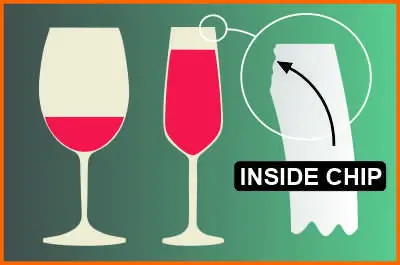
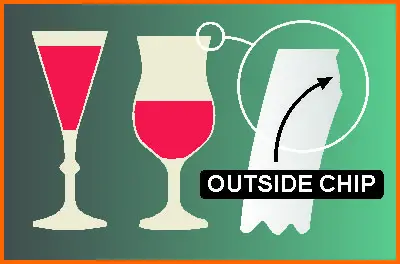
Beware – lead crystal is easier to chip than regular glass!
Lead has now been eliminated from most glass production for health reasons (see this post for more details), but many homes still display their prized collections of Waterford, Lalique, or Baccarat stemware. If you have lead crystal, remember that it is much softer than regular soda-lime glass and is therefore much easier to chip and to scratch. Never put it in the dishwasher!
Avoid chipping by careful handling – follow this advice
Check this post (coming soon) for comprehensive advice on taking care of crystal – but, in the meantime take note of this advice:-
- Remove rings & jewelry before washing crystal
- Wash glasses in warm soapy water – never in the dishwasher
- Hold crystal by the bowl – never the stem
- Never pour very hot liquid into crystal
- Check for water spots before storing your crystal
- Remove water spots with a mixture of vinegar & water
- Do not store crystal stemware resting on its rim
- Never store one crystal glass inside another one
- Change the water in a crystal flower vase daily
- Wash out a wine decanter after use to avoid staining
How do you tell if your glasses are made of lead crystal?
You have inherited a set of crystal stemware and decanters – or you have bought antique glass at an estate sale – how can you tell if your crystal contains lead?
Look for an etched trademark on the base of the glass to identify the maker. Crystal manufactured before the 1990s by prestigious companies like Waterford, Baccarat, Lalique, Stueben, Kosta Boda, Orrefors, and many others almost certainly contains 24 % PbO or more.
Try the tap test: carefully tap the rim of a glass with a metal object. Lead crystal glasses sound like a bell with a protracted ring, whereas soda-lime glasses make a dull, briefer sound. (However: many high-quality, lead-free crystal glasses, like those made by Reidel, also ring like a bell).
Examine the rim: Lead and other crystal glasses have “shear” rims whereas inexpensive restaurant-style glasses have “rolled” rims.
Compare the weight: lead crystal is noticeably heavier than glass.
Compare the “sparkle”: lead crystal has a higher refractive index and will generate rainbow-like colors when the decorative cuts are seen in sunlight.
Use a test kit: to analyze for lead – but see the limitations below
Lead Paint Test Kit provides instant tests on most painted, metal, and ceramic surfaces. The best way to check for leaded crystal is to leave vinegar in a glass for a couple of weeks, evaporate the remains then analyze the residue.
What are “grit” sizes?
Abrasives are calibrated by “grit sizes” with the higher the number being the coarser grit. You are probably familiar with sandpaper which ranges from 40 or 60 grit for removal of course material, through 320 to 600 grit for smoothing, and down to 1000, 2000, and even 5000 grit for polishing.
Wet and dry sandpaper is black to gray in color the abrasive is silicon carbide on a durable backing (instead of aluminum oxide or garnet on a paper backing for regular sandpaper).
How to choose the correct grit size
Consider the size of the chip when choosing the best sandpaper grit. A coarse grit will actually create small chips in the rim and therefore be counter-productive. For a large (> 1/4″ deep) chip, start with 120# or 200# to take off the sharp etches then gradually reduce the grit size to 800# or less to complete the smoothing.
Conclusion 1: expensive crystal glasses are worth repairing
Trust professionals like Artistry in Glass and Tucson Crystal & China Repair to fix your treasured lead crystal stemware.
Conclusion 2: inexpensive glasses – smooth them yourself
If you have an inexpensive glass with sentimental value – you can easily smooth the chip to make it safe to use.
Artistry in Glass was your source for antique repair in Tucson
Check out this amazing selection of informative articles:-
- Where can I get antiques repaired?
- Are broken antiques worth fixing?
- How to fix a broken picture frame
- How to repair a broken china plate
- How to repair a broken china teapot
- How to fix a broken marble slab
- How to repair a broken china coffee mug
- How to repair a 2000-year-old sculpture
- All about repairing stained-glass lampshades
- How to care for your stained glass skylight
- How to repair Dalle de Verre
- Is stained glass worth repairing?
- To repair or toss out?
- Tucson crystal & china repair a division of Artistry in Glass
- What to do with broken antiques
- Is lead crystal dangerous?
- Repairing an antique Mexican statue
- Repairing religious statues
- The history of Swarovski crystal figurines
- How to find the value of a Swarovski Crystal figurine
- Have Swarovski crystal figurines lost value since 2009?
- How to collect Swarovski annual ornaments
- How to display Swarovski crystal figurines
- How to authenticate a Swarovski crystal figurine
- How to display Swarovski annual ornaments
- How to clean Swarovski crystal figurines
- How to repair a Swarovski crystal mouse
- How to repair a Swarovski annual ornament
- How to repair a Swarovski crystal train set
- Fixing broken wine glass stems
- How to clean cloudy glasses
- Why do wine glasses have stems?
- Swarovski Crystal Figurines
- How to repair a chip in a wine glass
- How to fix a scratched glass tabletop
- How to replace a broken patio tabletop
Interested in mirrors? learn everything you need to know:
Unique Mirror Resources from Artistry in Glass
Mirror Design & layout
- How are mirrors made?
- What is a beveled mirror?
- What is a two-way mirror?
- Best mirrors for bedrooms
- How to size and position your wall mirror
- How to order custom etched mirrors
- Best places to hang dining room mirrors
- How much do wall mirrors cost?
- Shop the MIRROR Family Package
Mirror Installation & Removal
- How to hang a wall mirror
- How to frame a builder’s grade bathroom mirror
- How to hang a frameless mirror with glue
- Best clips for hanging mirrors
- How to attach a mirror to a closet door
- How to remove a mirror glued to the wall
Mirror Repair & Restoration
- Should I resilver my antique mirror?
- Can I repair scratched mirror silvering?
- What is the best spray paint for mirror silvering?
- How to fix a cracked mirror
- How to repair a broken mirror frame

